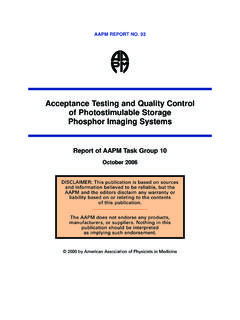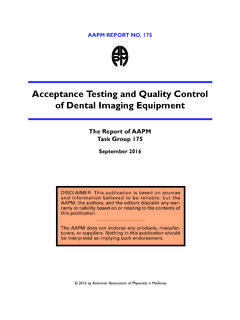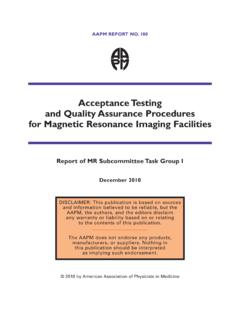Transcription of Basic Principles of Radiation Therapy Shielding Design
1 AAPM Physics Review July 19, 2014 Basic Principles of Radiation Therapy Shielding DesignPeter J. Biggs ,Massachusetts General Hospital,Harvard Medical School,Boston, MA 02114 AAPM Physics Review July 19, 2014 Outline1 Basic Principles and definitions2 Calculations3 Workload, use and occupancy factors4 Shielding materials5 Tenth value layers (TVL)6 Room layout & features, construction details7 Neutrons & laminated barriers8 Mazes and doors9 DuctsAAPM Physics Review July 19, 2014 DefinitionsP:Weekly Design dose limit (Sv/wk)d:Distance from target to measurement pointW:Workload (Gy/wk)U:Use FactorT:Occupancy factora:Scatter fraction.
2 ( , E)dsec:Distance from scatterer to measurement pointdsca:Distance from target to scattererdl:Distance from the target to measurement pointF:Area of the beam in the plane of the scatterer (cm2)B:Barrier transmission factorAAPM Physics Review Aug 3, 2013 Also IPEMR eport #75 AAPM Physics Review July 19, 2014 Basic PrinciplesThe purpose of Radiation Shielding is to reduce theeffective equivalent dose from a linear accelerator to apoint outside the room to a level that is determined byindividual or uncontrolled area - mSv per week- mSv in any one hourControlled area - 1 mSv/wk (in practice mSv/wk)AAPM Physics Review July 19, 2014 Basic Shielding Equations: NCRP #151 MethodologyPrimary:Scatter:Leakage.
3 WUTPdB2p F400ddaWTPB2sca2secs WTPd*1000B2ll Bxis the barriertransmissionfactorThe factor 1000 isdue to the requirementIinIoutoutxinIBI AAPM Physics Review July 19, 2014 Number of Tenth Value Layers (Primary & Leakage)The number, n, of tenth value layers (TVLs)required to reduce the dose to the value P isgiven by:and the thickness for primary and leakageradiation is given by: Bn10log elplpTVLnTVLT,1,)1( NCRP report No. 151 Table Physics Review July 19, 2014 Number of Tenth Value Layers for Scattered RadiationScatter TVLs are dependent only on energyand scattering angle, so:NCRP report No.
4 151, Table sssTVLnT AAPM Physics Review July 19, 2014 Tenth Value LayersPrimary TVLs (cm)*Energy (MV)4610151820 Concrete35(30) 37(33) 41(37) 44(41) 45(43) 46(44) TVLs at 90 * (cm)Energy (MV)4610151820 Concrete33(28) 34(29) 35(31) 36(33) 36(34) 36(34)Steel** ** * First term is 1st TVL and term in brackets is for all other TVLs. Data from NCRP #151** Data from McGinley AAPM Physics Review July 19, 2014 Obliquity Factor - IPAAPM Physics Review July 19, 2014 Obliquity factor - IIRule of thumb:-for >45 - and B< Add ~2 HVL for low-energy photons- And ~1 HVL for high-energy photonsAAPM Physics Review July 19, 2014 Obliquity factor - III- Experimental data by Kirn et.
5 Al. (1954)- verified by Biggs (1996) using the Monte Carlo for a large range of clinical energies- Monte Carlo results are in good agreement with previous recommendations at low energy, but more detail is given- Caveat: beware of applying obliquity factor corrections for large angles!!AAPM Physics Review July 19, 2014 Conventional Workload-Number of patients treated per week multipliedby the average dose (MU)/patient at isocenter-Include calibration, service, if indicated-Recommended values: 500 or 1000 Gy wk-1-Survey shows values from 250 to 450 Gy wk-1-Balance between high energy and low energyuse?
6 Using high energy is conservative approach-Electron-only (IORT) machines?AAPM Physics Review July 19, 2014 Workload TBI-Workload for TBI >> workload forconventional Therapy due to the extendeddistances:-Leakage workload is also higher, butpatient- and wall-scattered workload is usually directed at one barrier2 TBITBITBIdDW AAPM Physics Review July 19, 2014 Workload IMRT (1)-Workload for IMRT is complicated by the factthat the #MU is much larger than forconventional Therapy . The IMRT factor isdefined as:and varies between 2 and 10 or more-This only affects leakage Radiation , not primaryor scattered AAPM Physics Review July 19, 2014 Workload IMRT (2)-Helical tomotherapy has the highest C values, > based IMRT at MGH gives an average C valueof about 5-Impact of IMAT on MUs (VMAT, Rapid Arc) reduction of MUs-Anecdote: For a 6/18 MV machine the energy use priorto IMRT was 20%/80% (MU).
7 With 28% IMRT patientload, the use was 70%/30%. Hence need to considerbalancing the workload for two energiesAAPM Physics Review July 19, 2014 Conventional Use Factors90 interval:-0 (31%); 90 and 270 ( % each); 180 ( %)-previously, all barriers were assigned interval:-0 ( %); 45 and 315 ( % each); 90 and 270 ( % each); 135 and 225 (4 % each); 180 (23 %)AAPM Physics Review July 19, 2014 Use Factor for Conventional TherapyAAPM Physics Review July 19, 2014 Use Factors Special Cases-A significant TBI load will require onewall to have an increased use factor- IMRT may also require a change in thevalues assigned to the use factor for theprimary barrierAAPM Physics Review July 19.
8 2014 Use Factor Dedicated Machines-One should pay attention to the types ofprocedures to be carried out in new room-A room dedicated to SRS and SRT requiresdifferent considerations from a general therapyroom-A room dedicated to breast treatments will usespecific ranges of primary beam anglesAAPM Physics Review July 19, 2014 Example: Use Factor for Stereotactic RadiosurgeryAAPM Physics Review July 19, 2014 Workload - Summation (1)Primary:Patient scatter:(note that the TBI contribution is calculatedseparately source not at isocenter)..)( )(, QAIMRT convisoscatterWWWWAAPM Physics Review July 19, 2014 Workload - Summation (2)Leakage.
9 ( QAQAIMRTITBI convLWCWCWWWAAPM Physics Review July 19, 2014 Occupancy Factors-Occupancy factors down to 1/40 are now allowed-This is the limiting factor to permit mSv in any onehour using an MPD of mSv/wk-Area beyond vault door can now have an occupancy of 1/8-Caveat: be sure to check not only the occupancy of theimmediately adjacent area, but also the area beyond. Forexample, an office beyond a corridor becomes plans Physics Review July 19, 2014If the Dose Rate is High, Should I Freak Out?Note that even for a weekly limit of mSv/wk,the dose rate outside a barrier could be quite for a primary barrier, an occupancy of 1/40would imply a weekly dose of mSv and for abeam on time of hr, the instantaneous doserate is mSv/hr!)
10 !Moral: Choose factors wisely!!AAPM Physics Review July 19, 2014 Instantaneous Dose Rate (IDR)- NCRP recommends use of 1 hr as the minimum period for measuring IDR- Compares with many places ( , Europe) where the instantaneous dose rate at the highest dose delivery rate is used- Not an issue for occupancy of 1 for uniformly spaced treatments- Only an issue when treatments are not given uniformly throughout the 40 hr week or occupancy is <1 AAPM Physics Review July 19, 2014 Shielding MaterialsMaterialsDensityComments(g/cm2) ; High density concrete is very expensiveConcrete ; ; Lack structural integrity of Great for photons; bad for neutrons.










